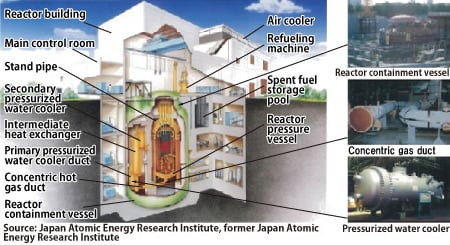High Temperature Gas-cooled Reactor
High Temperature Gas-cooled Reactor
High Temperature gas-cooled reactors produce thermal energy of approximately 1000°C using ceramic (such as silicon carbide) coated fuels and chemically inert helium gas coolant.
The Japan Atomic Energy Agency (JAEA, former Japan Atomic Energy Research Institute) began research and development of high temperature gas-cooled reactors for the multi-purpose use of nuclear / thermal energy in 1969. The latest product of these long-running efforts is the recently completed High Temperature Engineering Test Reactor (HTTR). MHI headed the design and construction group of this project and has developed software technologies to verify the performance and integrity of the reactor core and other high temperature structures as well as hardware technologies such as manufacturing high-temperature structures and heat exchangers.
MHI is now developing hydrogen production technology for the multi-purpose use of the high temperature gas-cooled reactor, and the helium gas turbine direct power generation system for high efficiency power generation. These technologies will be the key to the future commercialization of high temperature gas-cooled reactors.
MHI is also developing a gas-turbine system for the high-temperature gas power reactor PBMR project of PBMR Co. of the Republic of South Africa.
HTTR major parameters
Thermal output: 30MWt / Moderator: Graphite / Coolant:Helium(approx. 4MPa) / Reactor outlet temperature: 850°C(950°C)
HTTR major components MHI is in charge
Reactor containment vessel / Emergency air purification system / Main cooling system components: concentric hot gas duct, pressurized water coolers, helium circulator etc. / Reactor auxiliary system / Instrumentation and control system
HTTR key schedules
Construction start: March 1991 / Initial criticality: November 1998 / Rated output 30MW and attainment of reactor outlet coolant temperature 850°C: December 2001 / Attainment of reactor outlet temperature 950°C: April 2004
HTTR





